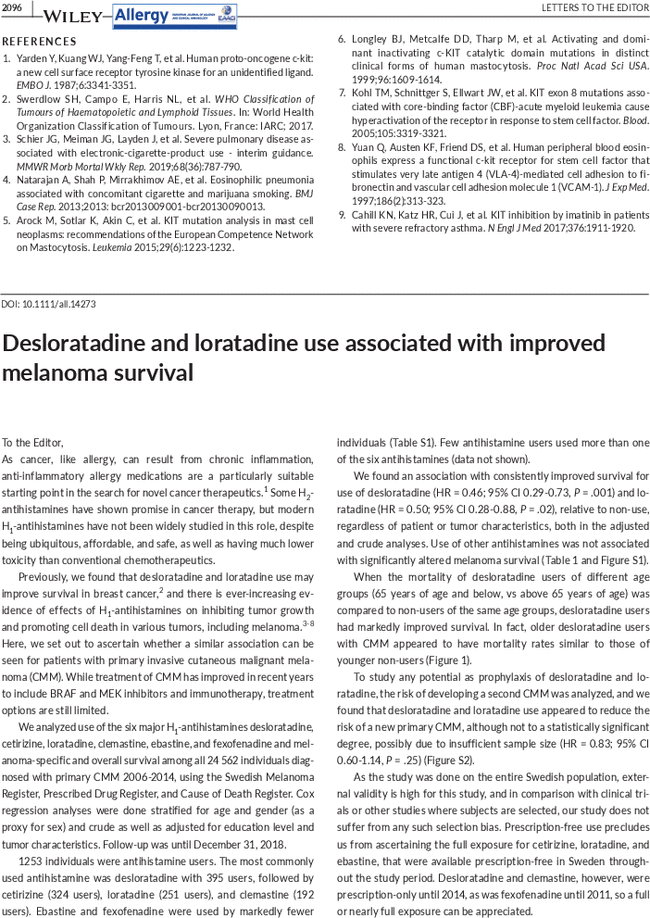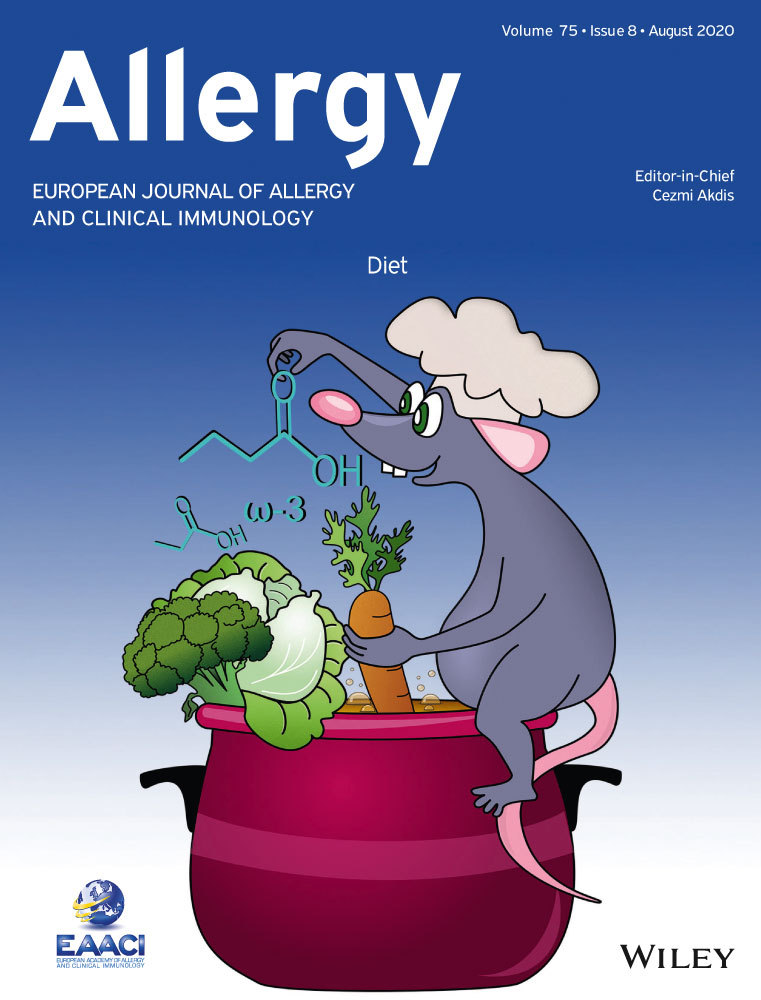Desloratadine and loratadine use associated with improved melanoma survival
Corresponding Author
Ildikó Fritz
Department of Cancer Epidemiology, Clinical Sciences, Lund University, Lund, Sweden
Correspondence
Ildikó Fritz, Lund University, Department of Cancer Epidemiology, Skåne University Hospital, Remissgatan 4, 221 85 Lund, Sweden.
Email: [email protected]
Search for more papers by this authorPhilippe Wagner
Department of Cancer Epidemiology, Clinical Sciences, Lund University, Lund, Sweden
Search for more papers by this authorMatteo Bottai
Division of Biostatistics, Institute of Environmental Medicine, Karolinska Institute, Solna, Sweden
Search for more papers by this authorHanna Eriksson
Department of Oncology and Pathology, Karolinska Institute, Solna, Sweden
Skin Cancer Center/Theme Cancer, Karolinska University Hospital, Solna, Sweden
Department of Oncology/Theme Cancer, Karolinska University Hospital, Solna, Sweden
Search for more papers by this authorChristian Ingvar
Department of Surgery, Clinical Sciences, Lund University, Lund, Sweden
Search for more papers by this authorIsabelle Krakowski
Department of Oncology and Pathology, Karolinska Institute, Solna, Sweden
Department of Dermatology/Theme Inflammation, Karolinska University Hospital, Solna, Sweden
Search for more papers by this authorKari Nielsen
Department of Dermatology, Clinical Sciences, Lund University, Lund, Sweden
Search for more papers by this authorHåkan Olsson
Department of Cancer Epidemiology, Clinical Sciences, Lund University, Lund, Sweden
Department of Oncology, Clinical Sciences, Lund University, Lund, Sweden
Search for more papers by this authorCorresponding Author
Ildikó Fritz
Department of Cancer Epidemiology, Clinical Sciences, Lund University, Lund, Sweden
Correspondence
Ildikó Fritz, Lund University, Department of Cancer Epidemiology, Skåne University Hospital, Remissgatan 4, 221 85 Lund, Sweden.
Email: [email protected]
Search for more papers by this authorPhilippe Wagner
Department of Cancer Epidemiology, Clinical Sciences, Lund University, Lund, Sweden
Search for more papers by this authorMatteo Bottai
Division of Biostatistics, Institute of Environmental Medicine, Karolinska Institute, Solna, Sweden
Search for more papers by this authorHanna Eriksson
Department of Oncology and Pathology, Karolinska Institute, Solna, Sweden
Skin Cancer Center/Theme Cancer, Karolinska University Hospital, Solna, Sweden
Department of Oncology/Theme Cancer, Karolinska University Hospital, Solna, Sweden
Search for more papers by this authorChristian Ingvar
Department of Surgery, Clinical Sciences, Lund University, Lund, Sweden
Search for more papers by this authorIsabelle Krakowski
Department of Oncology and Pathology, Karolinska Institute, Solna, Sweden
Department of Dermatology/Theme Inflammation, Karolinska University Hospital, Solna, Sweden
Search for more papers by this authorKari Nielsen
Department of Dermatology, Clinical Sciences, Lund University, Lund, Sweden
Search for more papers by this authorHåkan Olsson
Department of Cancer Epidemiology, Clinical Sciences, Lund University, Lund, Sweden
Department of Oncology, Clinical Sciences, Lund University, Lund, Sweden
Search for more papers by this author
Supporting Information
| Filename | Description |
|---|---|
| all14273-sup-0001-Supinfo.docxWord document, 341.3 KB | Supplementary Material |
Please note: The publisher is not responsible for the content or functionality of any supporting information supplied by the authors. Any queries (other than missing content) should be directed to the corresponding author for the article.
REFERENCES
- 1Faustino-Rocha AI, Ferreira R, Gama A, Oliveira PA, Ginja M. Antihistamines as promising drugs in cancer therapy. Life Sci. 2017; 172: 27-41.
- 2Olsson HL, Einefors R, Broberg P. Second generation antihistamines after breast cancer diagnosis to improve prognosis both in patients with ER+ and ER- breast cancer. J Clin Oncol. 2015; 33(15_suppl): 3062.
- 3Nicolau-Galmes F, Asumendi A, Alonso-Tejerina E, et al. Terfenadine induces apoptosis and autophagy in melanoma cells through ROS-dependent and -independent mechanisms. Apoptosis. 2011; 16(12): 1253-1267.
- 4Garcia-Quiroz J, Garcia-Becerra R, Santos-Martinez N, et al. In vivo dual targeting of the oncogenic Ether-a-go-go-1 potassium channel by calcitriol and astemizole results in enhanced antineoplastic effects in breast tumors. BMC Cancer. 2014; 14: 745.
- 5Varbanov HP, Kuttler F, Banfi D, Turcatti G, Dyson PJ. Screening-based approach to discover effective platinum-based chemotherapies for cancers with poor prognosis. PLoS ONE. 2019; 14(1):e0211268.
- 6Ellegaard AM, Dehlendorff C, Vind AC, et al. Repurposing cationic amphiphilic antihistamines for cancer treatment. EBioMedicine. 2016; 9: 130-139.
- 7Fagone P, Caltabiano R, Russo A, et al. Identification of novel chemotherapeutic strategies for metastatic uveal melanoma. Sci Rep. 2017; 7: 44564.
- 8Laverdiere I, Boileau M, Neumann AL, et al. Leukemic stem cell signatures identify novel therapeutics targeting acute myeloid leukemia. Blood Cancer J. 2018; 8(6): 52.
- 9Hemminki K, Forsti A, Fallah M, Sundquist J, Sundquist K, Ji J. Risk of cancer in patients with medically diagnosed hay fever or allergic rhinitis. Int J Cancer. 2014; 135(10): 2397-2403.
- 10Marasigan V, Morren MA, Lambert J, et al. Inverse association between atopy and melanoma: a case-control study. Acta dermato-venereologica. 2017; 97(1): 54-57.
- 11Wang H, Diepgen TL. Is atopy a protective or a risk factor for cancer? A review of epidemiological studies. Allergy. 2005; 60(9): 1098-1111.
- 12Eriksson NE, Holmen A, Hogstedt B, Mikoczy Z, Hagmar L. A prospective study of cancer incidence in a cohort examined for allergy. Allergy. 1995; 50(9): 718-722.




